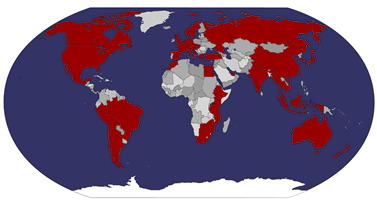
I get a good discount at Heaven – it’s clearly quiet as they haven’t had any guests sign in for several days (I’m clearly good luck for the guy as it fills up after me), but it’s a nice place, clean with hot water, and the owner is very friendly. The disadvantage is that it’s right at the bottom of town, and town is seriously spread up a hill. Of course, this does mean that at the end of the day you get to walk down, which there’s something to be said for – if one stays at the Seven Olives at the top, you have a summit to ascend to get back to your bed!

So I walk up, to get a feel for the place, plus I need to go to Ethiopian Air office, right at the very top. With all this cash-only for flight tickets rubbish I’ve realised that even with my dollars I’m about to run out of money. There’s plenty of mild hassle on the way up, which I ignore. I find the tourism office and Ethiopian Air offices both closed for lunch. Try again later. Given the choice of walking back down the hill to the churches, or going for lunch, well, I choose to stay “high”!
Incidentally – you know the standard footage of the Ethiopian famine – starving child with flies on his face? Well I’ll explain the latter part of it – there’s something about the damn flies here in that they *always* go for your face – walking through Lalibela I am forever swatting them away – they make bee-lines (fly-lines?) for your nose and worse – lips! How disgusting to have flies landing on your lips several times a day! I wonder why this is.. they don’t seem to go for the rest of me so much, not that I’ve noticed at least. Furthermore, the town is swarming with the buggers – must be lots of cattle about or something. Not pleasant.
So 121 US$ to Addis almost clears me out of my precious dollars, but I have enough birr left for a couple of beers before my flight, the day after tomorrow. As I point out to the chap, pointlessly I’m sure, it’s just rude to charge up to in some cases about 200US$ for domestic flights and then not take cards for payment. Somewhat ridiculously, he tells me I have to reconfirm my flight – tomorrow! I’m booking for the day after, surely you’re not going to change the schedules between now and then??
The Rock-Hewn Churches of Lalibela
Anyway, time for churches. Back down the hill, I enter the compound, and am waved to the ticket window. 200 birr for a ticket! That’s about 11 pounds! Shockingly expensive. I’ll tell you exactly what the money goes on too – there are clearly several projects underway to build protective roofs over the churches;

Work underway
– there will be foreign involvement in these projects, and therefore there will be expensive hotels and white 4x4s to be paid for.

One of the finished canopies
A home-grown project would not necessitate such an expensive entry fee. Remember this is a land where a 3.5 hours bus costs 18 birr and a beer is 6, so 200 is really off the scale. If you work on the beer scale, it’s like St. Pauls charging about 80 quid entry, which admittedly it doesn’t get far off – I think it was 8 pounds when Lucy and I went a couple of years ago.
Anyway, I pay up and (quite truthfully) tell the guides that I have no money but they’re welcome to guide me anyway. Of course, they’re not interested.
The History behind the Churches
Lalibela is said to be one of the greatest religious-historical sites in the Christian world, and is famous for the so-called rock-hewn churches, that is to say they took a hilly region, rich in red volcanic rock, and quite literally cut churches into the rock. Not dissimilar to Petra in Jordan, but here it’s not so much sculpting the face of the rock, more digging multi-story grand churches out of the ground. Up at 2500m, this site was intended to be a New Jerusalem in response to the capture of Jerusalem by Muslims in 1187, and many of its buildings takes their name from buildings in Jerusalem – apparently the river flowing through the town is called the River Jordan!
The driving force behind this was King Lalibela of the Zagwe dynasty, the ruler of Ethiopia in the late 12th or early 13th century, but I notice that King Kaleb, whose tomb I visited in Axum was responsible for a few of them too. It’s one of those sites where most information is in fact speculation, as it’s difficult for them to date the churches, except through the surviving religious records of the time. There are in total, depending on who you believe, either 11 or 12 churches. I myself lost count, and it’s difficult to keep track as you duck in and out of medieval dimly-lit passages, some pitch black, follow deep channels cut into the rock, descend into trapdoors, through hidden crypts and grottos.
The churches are grouped into four groups, three of which I visited. Next to the ticket area, one first reaches the Northern Group, often referred to as Group 1:
Northern Group: Bete Medhane Alem, home to the Lalibela Cross and believed to be the largest monolithic church in the world, probably a copy of St Mary of Zion in Aksum. It is linked to Bete Maryam (St. Mary’s) (possibly the oldest of the churches), Bete Golgotha (known for its arts and said to contain the tomb of King Lalibela), the Selassie Chapel and the Tomb of Adam.

The canopies which they are putting over all the churches

Descending to the first church which is under scaffolding, I reach the door. There are a couple of kids about and some local adults are coming out of the door. It’s clear I have to take my shoes off to go in. I’m not sure about whether this is the right door for me. The guy coming out says something in Amharic and waves his finger, what does this mean? The kids also are giving me conflicting messages. Eventually I get fed up and go in carrying my shoes. The kids try to pull them off me, but I shoo them away.
Inside it’s dim and not very exciting, a bit of a recurring theme to be honest.
Every church has in general:
1. Several medieval and modern paintings of scenes of the bible. Generally it’s minor variations on the same scenes
2. A priest with one or two staffs with ornate crosses which he will show you. It’s tradition that they point out how many crosses are on the cross, then count them for you.
3. Some unique architectural selling point – crosses on the ceiling, a certain number of pillars etc
4. A very bumpy floor, covered in thin mats so you can’t see when you’re about to twist your ankle
5. Very dark lighting so that photography is difficult
6. A large part of it sectioned off for the “Art of the Covenant”, a part which sometimes you can see has a load of junk piled up – for priests only though.
7. A ticket person floating about checking you’ve shelled out the 200 bucks.
8. Plenty of bird droppings about, though not many birds


A local woman steps up into a church
Though the interiors are not especially interesting (to me), I must say that their form and very existence is incredibly impressive on the outside.

They almost defy belief – that such beautiful buildings could be carved down into the rock as a single piece is truly something to be seen.

Walkways between churches cut deep too










Flag of St. George sits behind a painting

Arched ceiling







 Entrance
EntranceNext I walk round the road to the next group.

Hangman?
Eastern Group: Bete Amanuel (possibly the former royal chapel), Bete Merkorios (which may be a former prison), Bete Abba Libanos and Bete Gabriel-Rufael (possibly a former royal palace), linked to a holy bakery.









Breathe in
These churches, only a couple of minutes round the hill, are more interesting in that not only are there some huge fine churches, but also strange and interesting rock formations which themselves make the whole set up fun. There is a tunnel that must be 20m long or so, pitch black. I used my camera flash to avoid plunging down any unexpected holes.

The long tunnel

The trapdoor
Finally I stride into the open, yelling “No more churches!!” as I walk past an elderly Korean group heading up for another “session”, which yields sympathetic laughter. I throw in an anyonghasaeyo to impress them!
Walking down, end of working day, hundreds of labourers walking up with spades, axes etc, then thousands of kids, meaning an awful lot of hellos for me. I don’t mind this so much though, as they are honest greetings. I bump into a Belgium couple I’ve seen in a few places on the circuit, and we go for beers at Roha Pastry Shop, not far from our respective hotels.

Roha is the old name for Lalibela
In fact I end up back there again for dinner – shiro, injera and another beer and coffee, whilst chatting with the local lads about football – they’re all very disappointed England didn’t qualify for European cup.




No comments:
Post a Comment